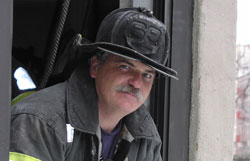By Ray McCormack
There are many topics in fire service training that hinge on annual certification. We have standards for annual hose testing, pump testing and nozzle testing, but no test for putting it all together; that is a disconnect. Material testing minus the human element. The problem is that firefighters put out fires, not objects. If you wish to advocate for something worthwhile, try annual attack certification where all the components are put together for us to evaluate how good we are at our trade.
This certification testing can be broken down into components like exterior, flanking, and aggressive interior. Participants can then formally recognize the differences between the methods if they didn’t know already and work their way through the progression. While testing of water delivery components is important, where is the importance placed on knowing how to use these tools within the system of fire attack? While it’s comforting to know that individual pieces are working, what comfort do we draw from not knowing what we are collectively capable of?
You can always drill on fire attack by stretching some hose and simulating how it’s done. You may even be able to add some fire to that training, but none of it is required: there is no certification, no paper to check off on that you know how to fight a fire and that your skills have been refreshed. This is not about adding another layer of bureaucracy. It has to do with a missed opportunity to deliver training in a constructive, standardized manor.
Who is to blame for this lack of annual certification? Us. Like many things in the fire service, somehow we missed this one. Do you need certification? Definitely. We have all of these other certification requirements, but none for actual firefighting, when lives are on the line. That is curious indeed. Even if we don’t have it formally, what we need to do is get to the place where operational hoseline skills are on a platform equal to or above other disciplines.
These other training topics did a better job of marketing their importance to the fire service while extinguishment lagged behind, and we let it happen. It’s actually disheartening to think that fire departments need to embrace fire, to build and rebuild the skills in their people to handle fire events. Without a formal push, many lag behind. The entrenchment of auxiliary topics and specialty education only push the basics back. Ever hear of “Back to Basics” classes? They exist because, on the fire service superhighway, the basics are often overtaken by current certification demands, new initiaves, and cultural training programs.
I don’t see the fire service adding another annual certification any time soon. It’s too busy worrying, about other things. It would seem that at least for the near future it is up to us to get our primary function–extinguishment–up to at least the recognition level. Imagine the fire service needing to recognize fire–it’s crazy. We embrace change in many areas; one change that would benefit us all would be to make sure our fire extinguishment skill sets, with or without annual certification, are the best they can be. Now that’s tactical safety.
Next Tactical Safety – Paint Us Resistive Red
 RAY McCORMACK is a lieutenant and 28-year veteran of the Fire Department of New York. He is the editor and publisher of Urban Firefighter Magazine. He delivered the keynote at FDIC in 2009, is lead instructor for Urban Essentials HOT, and the author of the “Tactical Safety” weekly safety column.
RAY McCORMACK is a lieutenant and 28-year veteran of the Fire Department of New York. He is the editor and publisher of Urban Firefighter Magazine. He delivered the keynote at FDIC in 2009, is lead instructor for Urban Essentials HOT, and the author of the “Tactical Safety” weekly safety column.

